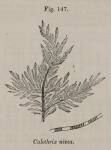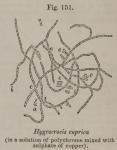 Characters.—Vesicular, filamentary, or membranous algals, propagated by sporidia (endogenous cells, or a gelatinous substance which is ultimately formed into cells), which are produced at the expense of the endochrome of one or more cells, or sometimes by the copulation of distinct individuals, and discharged by the opening or absorption of the mother cell.
Characters.—Vesicular, filamentary, or membranous algals, propagated by sporidia (endogenous cells, or a gelatinous substance which is ultimately formed into cells), which are produced at the expense of the endochrome of one or more cells, or sometimes by the copulation of distinct individuals, and discharged by the opening or absorption of the mother cell.
Properties.—These are similar to those of the order, and which I have already noticed (see ante, p. 50).
1. Confervals of mineral waters.—Confervals are peculiarly abundant in both hot and cold sulphureous springs. Calothrix nivea (Fig.147), the Conferva nivea of Dillwyn [British Confervae, p. 64.], has been found in the sulphur springs of Yorkshire, Durham, and Aix-la-Chapelle [Daubeny, Linn. Trans. vol. xvi. p. 587, 1831.]. The same, or an allied species, was found by Dr. Daubeny [Op. citato.] in the hot sulphur springs of Greoulx, in Provence. Oscillaria labyrinthiformis—the Tremella thermalis of some writers—is one of the most common species in the hot sulphur springs, and other thermal waters of Germany, France, and Italy. In the Karlsbad waters, Sphaerozyga Jacobi (Fig. 148), and several species of Oscillaria, have been detected [Endlicher, Genera Plant. Supp. 3me; Geiger's Handb. d. Pharm. 2te Aufl. Ergängsheft, 1843]. Humboldt found Oscillaria calida in the thermal waters of New Granada.
 The organic substance found in mineral waters, and variously called baregine by Longchamp, zoogen by Gimbernat, theiothermin by Monheim, and glairine by Anglada, derives its origin from confervals. It is a glairy or mucus-like substance, which is said to communicate the flavour and odour of flesh-broth to the water in which it is contained. In the preparation of artificial sulphur baths, animal gelatine is sometimes used to represent the baregine (see ante, vol. i. p. 478).
The organic substance found in mineral waters, and variously called baregine by Longchamp, zoogen by Gimbernat, theiothermin by Monheim, and glairine by Anglada, derives its origin from confervals. It is a glairy or mucus-like substance, which is said to communicate the flavour and odour of flesh-broth to the water in which it is contained. In the preparation of artificial sulphur baths, animal gelatine is sometimes used to represent the baregine (see ante, vol. i. p. 478).
The confervals, under the influence of light, decompose water, retain the hydrogen, and evolve the oxygen. Robiquet [Journ. de Pharmacie, t. xxi. p. 583, 1835.] obtained, from the Néris water, gas containing 44 per cent. of oxygen, derived from the Oscillatoria labyrinthiformis; and he ascribed the medicinal qualities of these waters to the presence of this very oxygenated air. "Dr. Edwards," says Robiquet, "has shown that the air contained in water has a great influence over the life of batrachians, and it is probable that, in some cases, our organs may also be more or less influenced by it."
2. Confervals employed in medicine.—Yeast is referred to Algae by Kützing [Phycologia generalis.], who calls it Cryptococcus Fermentum. It is more commonly, however, regarded as a fungus, and as such will be noticed hereafter. (See Fungi.) With this doubtful exception, none of the Confervals are employed, at the present day, in medicine. Nostoch commune, or star-jelly, of which, formerly, the most extraordinary superstitions were entertained [See the articles "Nostoch," in the Dict. Univ. de Mat. Méd. t. iv. p. 635, 1832; and "Californium," in James's Medicinal Dictionary, vol. ii.], and Conferva rivularis, or crow silk, recommended by Murray [Appar. Medicaminum, t. v. p. 550, 1790.—Pliny (Hist. Nat. lib. xxvii. cap. 45) says he knew a labourer who fell from the top of a tall tree, and thereby broke nearly every bone in his body, and who, being covered with a river conferva, kept moist by his own water, was cured in nn incredibly short space of time. He adds, that the term conferva is derived from "conferruminando," in allusion to the supposed consolidating properties of this plant.] for trial in asphyxia, asthma, and phthisis, on account of its evolving oxygen in solar light, have never been used in rational medicine.
3. Confervals developed in pharmaceutical and other liquids.—The vesicular and filamentous plants which grow in various chemical solutions [For some notices of these plants, the reader is referred to my paper On the Microscopic Vegetations developed in Pharmaceutical Liquids, in the Pharmaceutical Journal, vols. vii. and viii. 1818.], and to the naked eye appear like gelatinous or cottony masses, are considered by some botanists to be Algals. Kützing refers them to the genera Cryptococcus, Ulvina, Hygrocrocis, Sirocrocis, Leptomitus, and Chamaenema.

 But these minute plants are regarded by some eminent authorities as the spawn or mycelium of various moulds, or, in other words, as imperfect mucedinous fungi. "It is true," says the Rev. M. J. Berkeley, "that moulds will vegetate in fluids, but, as soon as they assume their normal form, there is a distinction between the immerged and free portion." If, however, they fructify under water, which, according to Kützing, they do, their algaceous nature is, I apprehend, proved.
But these minute plants are regarded by some eminent authorities as the spawn or mycelium of various moulds, or, in other words, as imperfect mucedinous fungi. "It is true," says the Rev. M. J. Berkeley, "that moulds will vegetate in fluids, but, as soon as they assume their normal form, there is a distinction between the immerged and free portion." If, however, they fructify under water, which, according to Kützing, they do, their algaceous nature is, I apprehend, proved.
4. Esculent Confervals.—Some few of the Confervals are cooked and brought to table under the name of laver; but the amount of nourishment which they contain is very small. They are species of Porphyra and Ulva.




